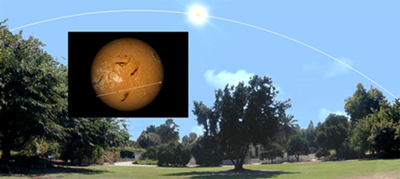| On Wednesday,
the planet Mercury will transit the Sun for the first time
since 2003 - there are only 13 transits
of Mercury each century.
November 3, 2006:: No. 65
A special astronomic occurrence will take place Wednesday,
Nov. 8, as the planet Mercury transits across the disc of
the sun. The last Mercury transit visible from the United
States was in 1999.
A special outdoor classroom will be set up on the grounds
of the Fullerton Arboretum at Cal State Fullerton to maximize
viewing opportunities from 11 a.m. to 4 p.m. Admission is
free and open to the public.
“If the weather is clear, the western United States will be able
to view the entire transit,” said Steve Karl, microscopist in the university’s
Biological Science Department. Karl added that a telescope equipped with the
appropriate solar filters would be required to view the event. Telescopes available
for public use at the Arboretum to witness this event will be a 10-inch Schmidt-Cassegrain,
4-inch apochromatic refractor and a 40-millimeter H-alpha solar telescope.
The transit start time is 11:12 a.m.; the transit maximum
is 1:41 p.m., and the transit end is 4:10 p.m.
A live video feed, plus real-time computer simulations and
demonstrations, also will be available for public viewing.
The telescopes are scheduled to be set up by 11 a.m. and
packed up by 4 p.m. The sun will set in the trees before
the end of the transit, but by then the viewing is expected
to be poor, noted Karl.
The transit or passage of a planet across the face of the
sun is a relatively rare occurrence. As seen from Earth,
only transits of Mercury and Venus are possible. On average,
there are 13 transits of Mercury each century. In comparison,
transits of Venus occur in pairs with more than a century
separating each pair.
The entire event will also be widely visible from Europe,
Africa and Asia. Japan, Australia and New Zealand will witness
the beginning of the transit, but the sun will set before the
event ends. Similarly, observers in western Africa, eastern
North America and eastern South America will see the end
of the event since the transit will already be in progress
at sunrise from those regions.
The next
Mercury transit is due May 9, 2016, at dawn, and the next
Venus transit is June 6, 2012, in the late afternoon.
The Fullerton Arboretum is located at 1900 Associated Road
on the northeast corner of Cal State Fullerton, one block
west of the Orange (57) Freeway at Yorba Linda Boulevard
and Associated Road. Parking is free. Additional information
is available from the Fullerton Arboretum at 657-278-3407
or www.arboretum.fullerton.edu
| Media Contacts: |
Steve Karl, microscopist, Biological Science Department,
657-278-2565 or skarl@fullerton.edu
Mark Costello, manager, Friends of the Fullerton Arboretum,
657-278-8347 or mcostello@fullerton.edu
Debra Cano Ramos, Public Affairs, 657-278-4027 or
dcanoramos@fullerton.edu |
«
back to News Front |
|
